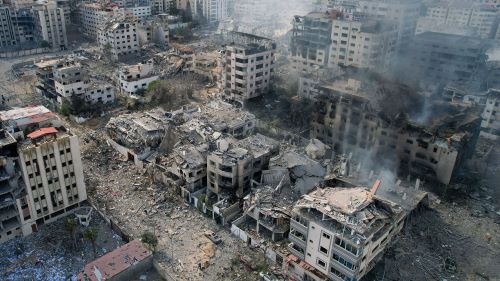Context-
The Gaza conflict, entrenched in historical grievances and geopolitical complexities, necessitates a multifaceted approach to resolution. In this comprehensive analysis, we look into recent developments, dissect the objectives and impacts of the involved parties, and propose a strategic exit strategy to pave the path for sustainable peace in the region.
Reviewing Recent Developments:
The recent adoption of a ceasefire resolution by the United Nations Security Council (UNSC) during Ramadan marked a pivotal moment in the Gaza conflict. However, subsequent reactions from Israel and Hamas underscored the fragility of the situation. While the resolution offered a glimmer of hope, Israel's initial reluctance and subsequent military escalations, alongside Hamas's conditional acceptance, highlight the persistent challenges in achieving a durable peace agreement.
Moreover, external factors, such as regional power dynamics and geopolitical rivalries, further complicate efforts to achieve a lasting peace agreement. In this context, ongoing diplomatic engagements and confidence-building measures are essential to consolidate the gains made through the ceasefire resolution. By addressing underlying grievances and fostering mutual trust, stakeholders can pave the way for sustained peace and stability in the region.
Analyzing War Objectives:
Both Israel and Hamas entered the conflict with distinct objectives, yet the outcomes have been nuanced. Israel's goals to dismantle Hamas, ensure the release of hostages, and quell rocket attacks have encountered significant hurdles. Moreover, the humanitarian toll of Israel's military campaign has garnered international condemnation, raising questions about the efficacy of its strategy. Moving forward, Israel must reassess its objectives and explore diplomatic avenues for resolving the conflict.
Despite extensive destruction, Hamas remains resilient, with its leadership largely intact and its capacity to launch attacks largely unaffected. Conversely, Hamas has succeeded in garnering international attention to Palestinian grievances and challenging the perceived invincibility of the Israeli military. However, the humanitarian cost of Hamas's actions, including the indiscriminate targeting of civilian populations, has also raised ethical and moral questions. Moving forward, Hamas must balance its military objectives with broader political considerations, prioritizing the well-being of the Palestinian people and exploring avenues for constructive engagement with Israel and the international community.
Understanding the Impacts:
The protracted conflict has exacted a heavy toll on both Israel and Gaza, manifesting in profound socio-economic and political ramifications. Israel's military losses, economic downturn, and strained diplomatic relations underscore the urgency for a recalibration of its approach. Furthermore, the humanitarian crisis in Gaza, characterized by widespread infrastructure devastation and loss of civilian lives, exacerbates long-term challenges and demands immediate attention.
Beyond the immediate humanitarian concerns, the Gaza conflict has broader geopolitical implications, shaping regional dynamics and global perceptions of security and stability in the Middle East. The erosion of trust between Israel and its regional allies, coupled with the rise of non-state actors and transnational terrorist networks, further complicates efforts to achieve a lasting peace agreement. Moreover, the destabilizing effects of the conflict extend beyond the region, with ripple effects felt across global markets and international institutions. In this context, concerted diplomatic efforts and sustained engagement are essential to address the root causes of the conflict and pave the way for a more secure and prosperous future for all stakeholders involved.
Crafting a Viable Exit Strategy:
● Strategic approach
A strategic exit strategy entails a comprehensive approach that addresses the military, political, and humanitarian dimensions of the conflict. Firstly, Israel must recognize the limitations of a purely military solution and pivot towards diplomatic initiatives. Ceasefire negotiations, coupled with a phased withdrawal of forces from Gaza, offer a tangible pathway towards de-escalation. Additionally, establishing a monitored buffer zone along the Gaza border can mitigate future hostilities while safeguarding Israel's security interests.
● Promoting Dialogue and Compromise:
Beyond immediate ceasefire efforts, a sustainable resolution hinges on fostering comprehensive dialogue and fostering mutual compromise between Israel and Palestine. Acknowledging the interdependence of their destinies, both parties must engage in sincere negotiations to delineate a viable two-state solution. This necessitates concessions and flexibility from entrenched positions, paving the way for mutual recognition and coexistence. Moreover, fostering grassroots reconciliation efforts and promoting people-to-people exchanges can cultivate a culture of peace and understanding.
● Facilitating International Mediation:
International mediation, spearheaded by regional powers and supported by the United Nations, is indispensable in catalyzing dialogue and providing tangible support for conflict resolution. Leveraging diplomatic channels and incentivizing cooperation can bolster confidence-building measures and bridge existing divides. Moreover, sustained engagement from the international community is imperative to ensure the implementation and enforcement of peace agreements. By galvanizing broad-based support and leveraging diplomatic leverage, international actors can play a pivotal role in facilitating a just and lasting resolution to the Gaza conflict.
Conclusion:
The Gaza conflict presents a formidable challenge that demands a comprehensive and inclusive approach toward resolution. By reassessing objectives, prioritizing humanitarian concerns, and fostering genuine dialogue, Israel and Palestine can chart a course toward enduring peace and stability. Through concerted efforts and international solidarity, a strategic exit strategy can transform the dynamics of the conflict, paving the way for a brighter future for all stakeholders in the region.
|
Probable Questions for UPSC Mains Exam- 1. Discuss the recent developments in the Gaza conflict and analyze the challenges encountered in achieving a durable peace agreement, considering the reactions of both Israel and Hamas to the ceasefire resolution passed by the United Nations Security Council. (10 Marks, 150 Words) 2. Evaluate the objectives and impacts of both Israel and Hamas in the Gaza conflict, highlighting the complexities and nuances of their respective strategies. Assess the effectiveness of Israel's military campaign and Hamas's resistance efforts in light of humanitarian concerns and geopolitical implications.. (15 Marks, 250 Words) |
Source- The Hindu







